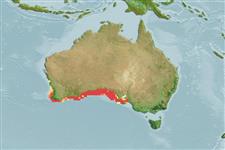分類 / Names
俗名 | 同種異名 | Catalog of Fishes(屬, 種) | ITIS | CoL | WoRMS | Cloffa
Teleostei >
Perciformes/Scorpaenoidei (Scorpionfishes)
鮋形目 (Scorpionfishes) >
Neosebastidae (Gurnard scorpionfishes)
Neosebastidae (Gurnard scorpionfishes)
Etymology: Neosebastes: Greek, neos = new + Greek, sebastes = august, venerable (Ref. 45335).
More on author: Cuvier.
Environment: milieu / climate zone / depth range / distribution range
生態學
海洋 礁區魚類; 深度上下限 10 - 100 m (Ref. 9563). 亞熱帶的; 29°S - 36°S
Eastern Indian Ocean: endemic to Australia.
東印度洋: 澳洲。
大小 / 重量 / 年齡
Maturity: Lm ? range ? - ? cm
Max length : 40.0 cm TL 雄魚/尚未辨別雌雄; (Ref. 33839)
背棘 (總數): 8; 背的軟條 (總數): 8; 臀棘 3; 臀鰭軟條: 5. Diagnosis: Dorsal rays XIII, 8 (9 in 1 of 20 specimens), third spine longest. Anal rays III, 5. Pectoral rays 20 or 21 (mode 21; 18 in 1 of 20 specimens), distal margin bilobed. Pored lateral-line scales 33-38 (34); longitudinal scale series 62-69 (66); scale rows between base of last dorsal spine and lateral line 7 or 8 (8). Well-developed gill rakers on upper limb 0 or 1 (1), lower limb 5-7 (6), total 5-8 (7); rudimentary gill rakers on upper limb 3-5 (4), lower limb 3-6 (5). Swim bladder absent. Dorsal profile of snout not steep, forming angle of about 50-55° to horizontal axis of head and body. Nasal spine simple (sometimes with 2 points), directed upward or slightly backward, length of former greater than anterior nostril diameter. Posterior margin of premaxilla ascending process extending beyond level of middle of posterior nostril when mouth closed. Interorbital ridge distinct; no scales on midinterorbital space or posterior half of supraorbital, but large and prominent on anterior half of supraorbital above interorbital ridge and on distal margin of supraorbital bone. Interorbital space extremely deep, but only about one-eighth of orbit extending above dorsal profile of head. Preocular with a small simple spine, its length less than that of nasal spine. Supraocular ridge with 3-6 prominent pointed spines, not strongly canted laterally; middle part of supraocular ridge located about midway between interorbital ridge and orbit in dorsal view. Sphenotic with a large spine and 3-7 minute spines. Postorbital spine flattened and serrated. Long, narrow and extremely deep transversal occipital pit, not covered with scales; a cluster of irregular scales protruding along front and behind sides of occipital pit; occipital pit curved posteriorly behind orbit, not covered with scales. Nuchal and supracleithral spines simple. Pterotic spine usually simple (sometimes with 2 points), originating slightly posterior to nuchal spine, base slightly smaller than that of latter. Upper posttemporal spine flattened, smooth or serrated; lower posttemporal spine simple (rarely with 2 points). Posterior margin of maxilla not extending beyond a vertical at posterior margin of pupil. Maxilla with scales extending from below posterior edge of anterior lacrimal spine to posterior margin of maxilla. Underside of mandible with 3 distinct pores and longitudinal ridges on each side, including an inner ridge extending from under lower jaw lip to lower edge of opercle, an outer ridge extending to lower edge of preopercle, and a central ridge extending to posterior part of angular and bearing the third pore posteriorly; distinct lacrimal ridge with 1-4 points. Anterior lacrimal spine usually simple (anterior edge sometimes serrated), directed ventroposteriorly (rarely forward). Posterior lacrimal spine with 1 or 2 points, directed ventroposteriorly; length of anterior lacrimal spine 2 times or less in that of posterior lacrimal spine. Suborbital pit present, front rimmed by a vertical (sometimes oblique) ridge on lacrimal to ventroanterior margin of orbit; large scales on entire suborbital pit. Suborbital ridge with 3-6 pointed spines in line with lacrimal ridge, spines joined at bases, directed backward. no scales between ventral margin of orbit and suborbital ridge, or on eye membrane. Preopercle with 5 spines, 4 lower spines simple, lacking a median ridge, uppermost spine with a median ridge and with a spine (rarely 2 spines) distally; length of uppermost preopercular spine slightly greater than or approximately equal to pupil diameter. Upper opercular spine simple, no median ridge; lower opercular spine simple with a median ridge; tip of lower opercular spine usually not extending beyond (rarely extending slightly beyond) opercular margin (Ref. 54394).
Body reddish brown, with large darker brown patch beneath dorsal fin anteriorly and smaller patches on dorsal half of body posteriorly; lower part of body with irregular orange spots; depth 35-39% SL. Head large 41-46%SL; eyes large 31-37%HL, protruding only slightly above dorsal profile. Caudal fin 13 (Ref. 33839). Lateral line almost straight, lacking the short curve at origin (Ref. 12723).
身體紅褐色的, 在後部地前面地在背鰭之下有大的深褐色的小區塊與在背部一半的身體上較小的區塊; 身體下半部有不規則的橘色斑點; 深度 35-39% SL。 頭部大的 41-46% SL; 眼大的 31-37% HL, 伸出只些微地高於背面輪廓。 尾鰭 13.(參考文獻 33839) 側線幾乎直, 缺乏在起源的短彎曲.(參考文獻 12723)
A temperate species found inshore on reefs (Ref. 7300).
發現的一個溫帶的種在沿海的礁。 (參考文獻 7300)
Life cycle and mating behavior
成熟度 | 繁殖 | 產卵場 | 卵 | 孕卵數 | 仔魚
東印度洋: 澳洲。
Motomura, H., 2003. Revision of the scorpionfish genus Neosebastes (Scorpaeniformes: Neosebastidae), with descriptions of five new species. Indo-Pac. Fish. (37):46 p. (Ref. 54394)
人類使用
更多資訊
俗名同種異名新陳代謝捕食者生態毒物學繁殖成熟度產卵場產卵群集孕卵數卵卵發育
年龄/大小成長長度-重量長度-長度長度-頻率形態測量圖型態特徵仔魚稚魚動力學入添量豐度BRUVS
參考文獻養殖養殖資訊品種遺傳學Electrophoreses遺傳率疾病加工NutrientsMass conversion
合作者照片Stamps, Coins Misc.聲音神經毒速度泳型鰓區Otoliths腦重體重比眼睛色素
工具
特別的報告
下載 XML
網路資源
Estimates based on models
Preferred temperature (Ref.
123201): 17 - 18.7, mean 18 °C (based on 106 cells).
Phylogenetic diversity index (Ref.
82804): PD
50 = 0.5002 [Uniqueness, from 0.5 = low to 2.0 = high].
Bayesian length-weight: a=0.01995 (0.00906 - 0.04395), b=3.01 (2.83 - 3.19), in cm total length, based on all LWR estimates for this body shape (Ref.
93245).
營養階層 (Ref.
69278): 3.8 ±0.5 se; based on size and trophs of closest relatives
Fishing Vulnerability (Ref.
59153): Low to moderate vulnerability (30 of 100).
Nutrients (Ref.
124155): Calcium = 15.3 [6.3, 32.1] mg/100g; Iron = 0.203 [0.095, 0.400] mg/100g; Protein = 17.8 [16.2, 19.4] %; Omega3 = 0.402 [0.165, 1.321] g/100g; Selenium = 9.84 [4.39, 23.28] μg/100g; VitaminA = 36.4 [8.2, 176.0] μg/100g; Zinc = 0.537 [0.343, 0.847] mg/100g (wet weight);
